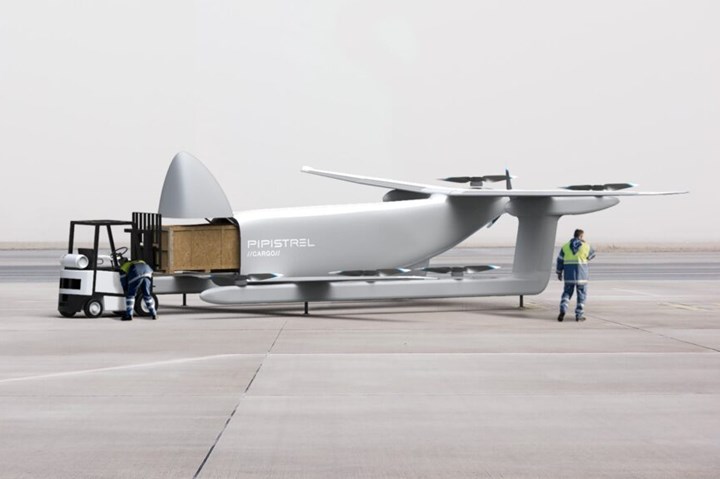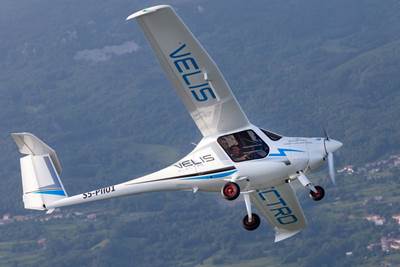Pipistrel accepts orders for Nuuva series eVTOL aircraft
The Nuuva V300 is a long-range autonomous eVTOL UAV for logistics and aerial cargo delivery. It is considered more economical, safe and reliable compared to conventional helicopters.

An artistic rendition of the Nuuva V300 loading with a forklift. Photo Credit: Pipistrel
Small aircraft designer and manufacturer, Pipistrel Aircraft (Ajdovščina, Slovenia) presented on Sept. 1 the Nuuva V300 as the flagship model of the Nuuva series of unmanned air vehicles (UAVs), and has begun accepting orders. According to Pipistrel, this aircraft embodies the company’s vision to disrupt aerial cargo transportation by commercializing the use of electrical vertical take-off and landing (eVTOL) vehicles. Customizable, the long-range autonomous aircraft is said to be able to carry up to 460 kilograms, is easy and economical to operate and offers the efficiency and reliability of electric powertrains. Entry into service is planned for the second half of 2023.
According to Pipistrel, the Nuuva family combines the best of both airplane and helicopter air cargo transportation principles; the unmanned eVTOL capability enables it to enter spaces airplanes cannot, and its hybrid configuration allows it to operate at a fraction of the cost of a helicopter on an equivalent mission. The Nuuva V300, says Pipistrel, is targeting to deliver ten times the improvement in economics to the operator.

An artistic rendition of the aircraft in flight
The large cargo compartment accepts up to three Euro-pallets (EPAL) that are reportedly easy to load with a regular forklift. The Nuuva V300 then flies a preloaded flight plan fully autonomously, controlled by a digital flight control system. Continuous communication allows the ground operator, who manages the vehicle, to have complete control in case of changes or cancellation of the flight.
Pipistrel says the aircraft takes off and lands using eight independent battery-powered Pipistrel E-811 electric engines, already Type Certified (TC). Further, the whole system is safeguarded by an integrated health self‑monitoring system that alerts of any potential malfunction before they occur, increasing reliability and safety. Further, Nuuva V300’s batteries can be charged by plugging-in to a SkyCharge by Pipistrel and Green Motion charging station.
In addition, the aircraft has improved fuel economy and low maintenance costs via an internal combustion engine in the aft fuselage, and a tandem-wing configuration with fly-by-wire control surfaces are said to boost the aerodynamic efficiency and reduce the landing footprint of the vehicle.
Pipistrels points to the aircraft’s ability to be customized for a wide range of missions. For operators that prioritize longer range, the vehicle’s payload capacity and anti-ice capabilities can be traded off for more usable fuel, and an ability to transport 50-kilogram payload for as far as 2,500 kilometers, all this without compromising the ability to take-off and land vertically from altitudes as high as 8,000 feet. At lower take-off altitudes and with shorter mission requirements, the company says the payload can be increased to up to 460 kilograms.
Included in the Nuuva family is the Nuuva V20. The smaller of the family aircraft, the V20 is said to share the same architecture and advantages of the larger V300 but is designed as a lightweight cargo courier carrying payloads of up to 20 kilograms. First customers will be able to take deliveries as early as 2021.
Related Content
Novel dry tape for liquid molded composites
MTorres seeks to enable next-gen aircraft and open new markets for composites with low-cost, high-permeability tapes and versatile, high-speed production lines.
Read MoreMaterials & Processes: Fibers for composites
The structural properties of composite materials are derived primarily from the fiber reinforcement. Fiber types, their manufacture, their uses and the end-market applications in which they find most use are described.
Read MoreOne-piece, one-shot, 17-meter wing spar for high-rate aircraft manufacture
GKN Aerospace has spent the last five years developing materials strategies and resin transfer molding (RTM) for an aircraft trailing edge wing spar for the Airbus Wing of Tomorrow program.
Read MorePlant tour: Spirit AeroSystems, Belfast, Northern Ireland, U.K.
Purpose-built facility employs resin transfer infusion (RTI) and assembly technology to manufacture today’s composite A220 wings, and prepares for future new programs and production ramp-ups.
Read MoreRead Next
Velis Electro all-electric aircraft obtains type certificate
Obtained from EASA, the Type Certification furthers Pipistrel’s goal for sustainable and emissions-free aircraft.
Read MoreCW’s 2024 Top Shops survey offers new approach to benchmarking
Respondents that complete the survey by April 30, 2024, have the chance to be recognized as an honoree.
Read MoreComposites end markets: Energy (2024)
Composites are used widely in oil/gas, wind and other renewable energy applications. Despite market challenges, growth potential and innovation for composites continue.
Read More
















.jpg;maxWidth=300;quality=90)









